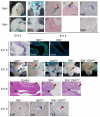Dosage-dependent hedgehog signals integrated with Wnt/beta-catenin signaling regulate external genitalia formation as an appendicular program
- PMID: 19906864
- PMCID: PMC2778744
- DOI: 10.1242/dev.039438
Dosage-dependent hedgehog signals integrated with Wnt/beta-catenin signaling regulate external genitalia formation as an appendicular program
Abstract
Embryonic appendicular structures, such as the limb buds and the developing external genitalia, are suitable models with which to analyze the reciprocal interactions of growth factors in the regulation of outgrowth. Although several studies have evaluated the individual functions of different growth factors in appendicular growth, the coordinated function and integration of input from multiple signaling cascades is poorly understood. We demonstrate that a novel signaling cascade governs formation of the embryonic external genitalia [genital tubercle (GT)]. We show that the dosage of Shh signal is tightly associated with subsequent levels of Wnt/beta-catenin activity and the extent of external genitalia outgrowth. In Shh-null mouse embryos, both expression of Wnt ligands and Wnt/beta-catenin signaling activity are downregulated. beta-catenin gain-of-function mutation rescues defective GT outgrowth and Fgf8 expression in Shh-null embryos. These data indicate that Wnt/beta-catenin signaling in the distal urethral epithelium acts downstream of Shh signaling during GT outgrowth. The current data also suggest that Wnt/beta-catenin regulates Fgf8 expression via Lef/Tcf binding sites in a 3' conserved enhancer. Fgf8 induces phosphorylation of Erk1/2 and cell proliferation in the GT mesenchyme in vitro, yet Fgf4/8 compound-mutant phenotypes indicate dispensable functions of Fgf4/8 and the possibility of redundancy among multiple Fgfs in GT development. Our results provide new insights into the integration of growth factor signaling in the appendicular developmental programs that regulate external genitalia development.
Figures







Similar articles
-
Unique functions of Sonic hedgehog signaling during external genitalia development.Development. 2001 Nov;128(21):4241-50. doi: 10.1242/dev.128.21.4241. Development. 2001. PMID: 11684660
-
Temporal and spatial dissection of Shh signaling in genital tubercle development.Development. 2009 Dec;136(23):3959-67. doi: 10.1242/dev.039768. Development. 2009. PMID: 19906863 Free PMC article.
-
Regulation of outgrowth and apoptosis for the terminal appendage: external genitalia development by concerted actions of BMP signaling [corrected].Development. 2003 Dec;130(25):6209-20. doi: 10.1242/dev.00846. Epub 2003 Nov 5. Development. 2003. PMID: 14602679
-
Development of the external genitalia: conserved and divergent mechanisms of appendage patterning.Dev Dyn. 2011 May;240(5):1108-15. doi: 10.1002/dvdy.22631. Epub 2011 Apr 4. Dev Dyn. 2011. PMID: 21465625 Free PMC article. Review.
-
Cross-talk of WNT and FGF signaling pathways at GSK3beta to regulate beta-catenin and SNAIL signaling cascades.Cancer Biol Ther. 2006 Sep;5(9):1059-64. doi: 10.4161/cbt.5.9.3151. Epub 2006 Sep 4. Cancer Biol Ther. 2006. PMID: 16940750 Review.
Cited by
-
Hormonal and Molecular Regulation of Phallus Differentiation in a Marsupial Tammar Wallaby.Genes (Basel). 2020 Jan 16;11(1):106. doi: 10.3390/genes11010106. Genes (Basel). 2020. PMID: 31963388 Free PMC article. Review.
-
Isl1 mediates mesenchymal expansion in the developing external genitalia via regulation of Bmp4, Fgf10 and Wnt5a.Hum Mol Genet. 2018 Jan 1;27(1):107-119. doi: 10.1093/hmg/ddx388. Hum Mol Genet. 2018. PMID: 29126155 Free PMC article.
-
Genetics of Bladder-Exstrophy-Epispadias Complex (BEEC): Systematic Elucidation of Mendelian and Multifactorial Phenotypes.Curr Genomics. 2016 Feb;17(1):4-13. doi: 10.2174/1389202916666151014221806. Curr Genomics. 2016. PMID: 27013921 Free PMC article.
-
Genetic evidence that SOST inhibits WNT signaling in the limb.Dev Biol. 2010 Jun 15;342(2):169-79. doi: 10.1016/j.ydbio.2010.03.021. Epub 2010 Mar 30. Dev Biol. 2010. PMID: 20359476 Free PMC article.
-
Germ layer differentiation during early hindgut and cloaca formation in rabbit and pig embryos.J Anat. 2010 Dec;217(6):665-78. doi: 10.1111/j.1469-7580.2010.01303.x. Epub 2010 Sep 28. J Anat. 2010. PMID: 20874819 Free PMC article.
References
-
- Ahn K., Mishina Y., Hanks M. C., Behringer R. R., Crenshaw E. B., 3rd (2001). BMPR-IA signaling is required for the formation of the apical ectodermal ridge and dorsal-ventral patterning of the limb. Development 128, 4449-4461 - PubMed
-
- Araki K., Imaizumi T., Okuyama K., Oike Y., Yamamura K. (1997). Efficiency of recombination by Cre transient expression in embryonic stem cells: comparison of various promoters. J. Biochem. 122, 977-982 - PubMed
-
- Beermann F., Kaloulis K., Hofmann D., Murisier F., Bucher P., Trumpp A. (2006). Identification of evolutionarily conserved regulatory elements in the mouse Fgf8 locus. Genesis 44, 1-6 - PubMed
-
- Benazet J. D., Bischofberger M., Tiecke E., Goncalves A., Martin J. F., Zuniga A., Naef F., Zeller R. (2009). A self-regulatory system of interlinked signaling feedback loops controls mouse limb patterning. Science 323, 1050-1053 - PubMed
Publication types
MeSH terms
Substances
Grants and funding
LinkOut - more resources
Full Text Sources
Molecular Biology Databases
Miscellaneous

